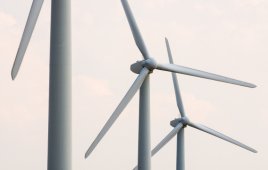Letha Tawney, Celina Bonugli and Daniel Melling
U.S. homeowners, businesses and institutions alike rely on utilities to provide consistent, affordable electricity. These consumers increasingly want renewable power, but our current markets prevent many of them from getting it.
In traditional electricity markets, customers are not able to directly engage with renewable energy facilities to purchase energy. They can only buy energy from their local utility, so they can’t easily access fixed-price renewable energy.
To address this issue and provide more access to affordable renewable energy, traditional utilities in the United States are starting to offer large-scale renewable energy purchasing programs, called “green tariffs.” Through green tariffs, customers are able to source up to 100% of their electricity from renewable resources through a fixed rate.
WRI’s updated issue brief, Emerging Green Tariffs in US Regulated Electricity Markets, shows that as of September 2016, traditional utilities in the United States have created 10 green tariff options, twice the number that existed at the end of 2015. Utilities offering these large-scale renewable energy purchasing programs include some of the country’s largest shareholder-owned utilities, like Xcel Energy and Duke Energy.
The 10 green tariff options available or proposed today increase access to renewable energy in eight states and create the opportunity for large buyers like corporations and manufacturers to pursue hundreds of megawatts of new, renewable energy in the coming months.
These emerging green tariffs have already helped usher in more wind and solar within traditional electricity markets that tend to rely more heavily on coal. Since 2015, more than 450 MW of new, additional solar were contracted via green tariffs, avoiding an estimated 554,000 metric tons of CO2 annually. That’s the equivalent of taking almost 118,000 vehicles off the road each year. More than 500 megawatts of deals are currently under negotiation. And the five new green tariffs approved in 2016 means even more new renewable energy deals will emerge.
Green Tariff Variations
Over the past three years, green tariffs have taken various forms:
- Tariffs & Riders: Tariffs replace the standard electricity rate customers are charged on their bills with the cost of the renewable energy. Riders, on the other hand, are added on top of the standard rates. Riders are usually the total of the cost of the renewable energy and a credit for the fossil-fueled power the customer replaced. Generally speaking, both tariffs and riders serve a larger load by enabling a power purchase agreement (PPA), a direct contract with a renewable energy project through the utility and directly to the customer.
- Subscriber Programs: These programs allow customers to subscribe to very small amounts of energy from a larger renewable energy project(s) and replace the standard charge for fossil-fueled power on their bill. The utility aggregates these smaller customers to make a single, larger project more cost-effective.
Green tariffs embraced by utilities & public utility commissions
Green tariffs, proposed by traditional utilities and approved by electricity regulators known as Public Utility Commissions (PUCs), vary across the country and are still relatively complex. Typical elements, however, include the ability to match customers’ large-scale renewable energy goals by providing Renewable Energy Certificates (RECs) bundled with the energy from the project. Utilities offer green tariffs at a competitive, long-term fixed price that reflects the direct cost of generating and delivering the renewable energy. This allows customers to mitigate the risk of future fossil-fuel price fluctuations in their electricity bill. By only charging participating customers for the cost of the renewable energy, green tariffs avoid shifting costs and risks of the program to non-participating customers, such as households.
The increase in green tariff proposals around the country indicate that utilities are seeking out products that meet customer needs. In some states, utilities have created more than one green tariff option, increasing the opportunity to meet varying renewable energy demand. PUCs have also grown more familiar with successful green tariff elements and more comfortable that they won’t impact other customers. As a result, PUCs have been quicker to approve green tariffs this summer, with more approvals expected in the coming months.
In the end, the utility maintains positive, long-term relationships with their customers, the customer enjoys access to renewable power at cost-effective prices and the PUC is reassured that the program minimizes risks for all parties involved in the electricity system.
Large commercial and industrial customers play a role in driving growth
The growth in green tariffs in U.S. energy markets does not just mean gains for utilities, major companies and states seeking economic development. The public also benefits from the direct and early emissions reductions associated with renewable energy use, which cuts local air pollution and reduces the risks of climate change.
Ultimately, green tariffs create a path forward for renewable energy within a utility business model that customers already rely on to purchase their electricity. We’ll continue to keep track of green tariffs’ evolution in the United States by regularly updating the Emerging Green Tariffs issue brief throughout the year.
Filed Under: Policy





